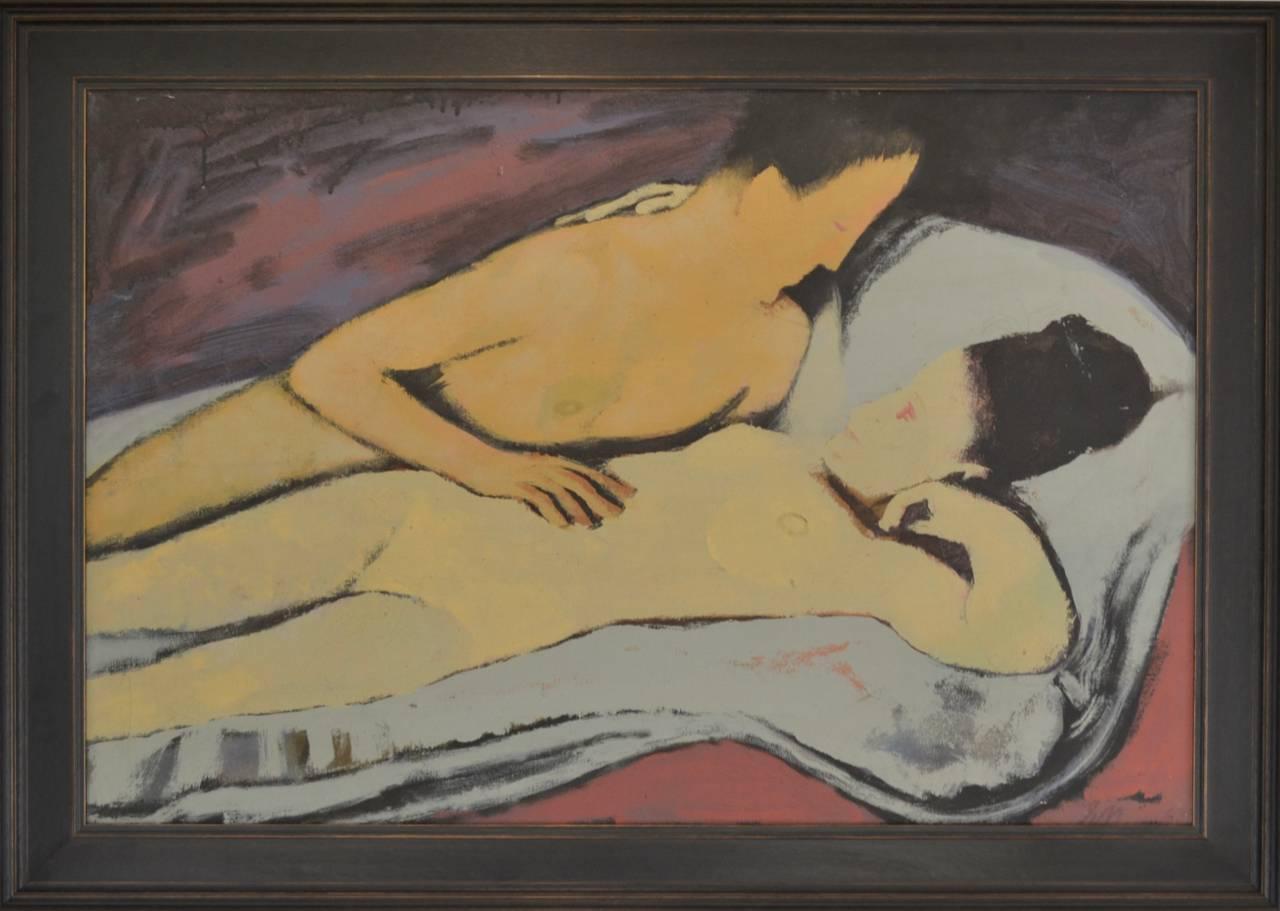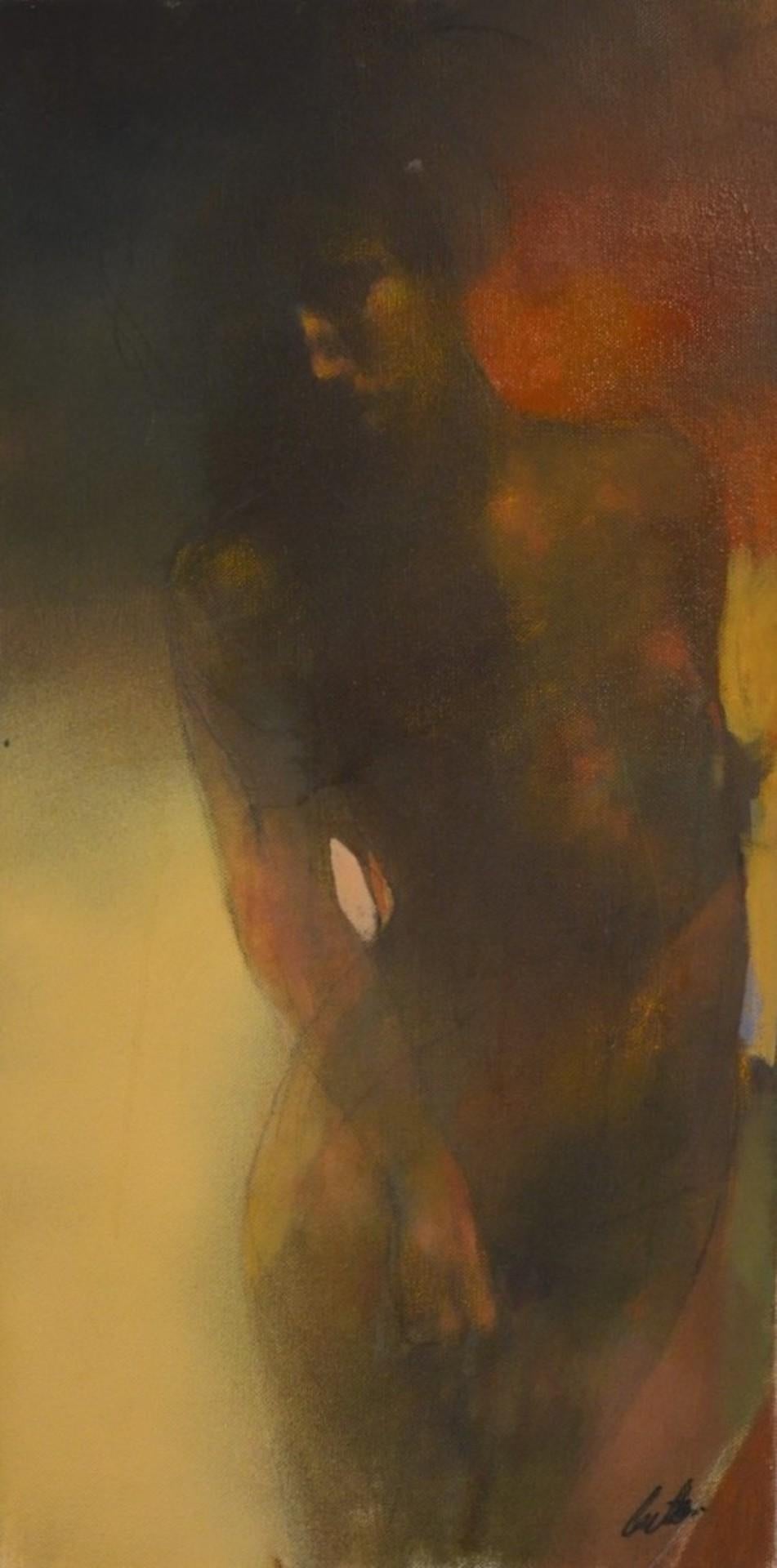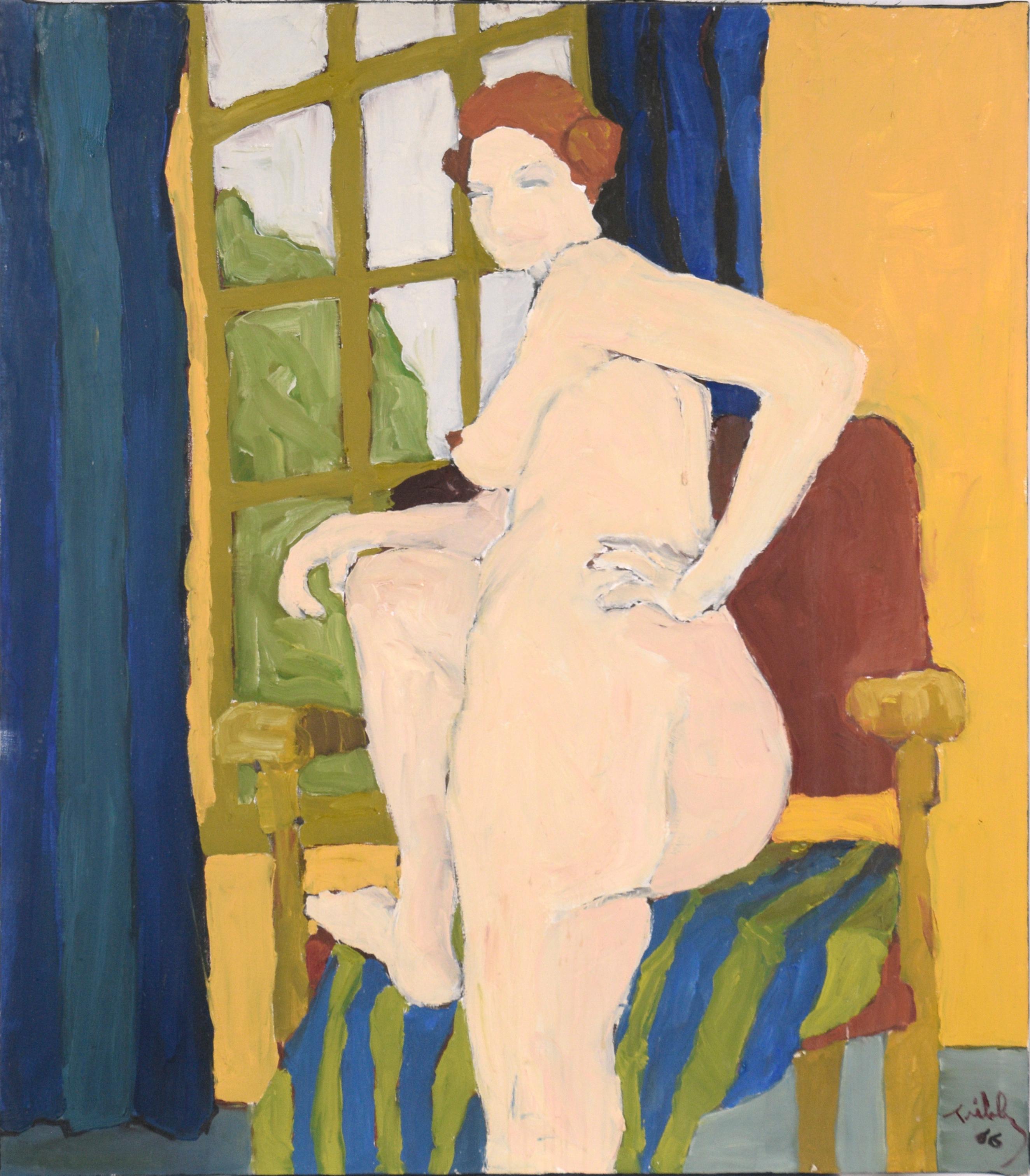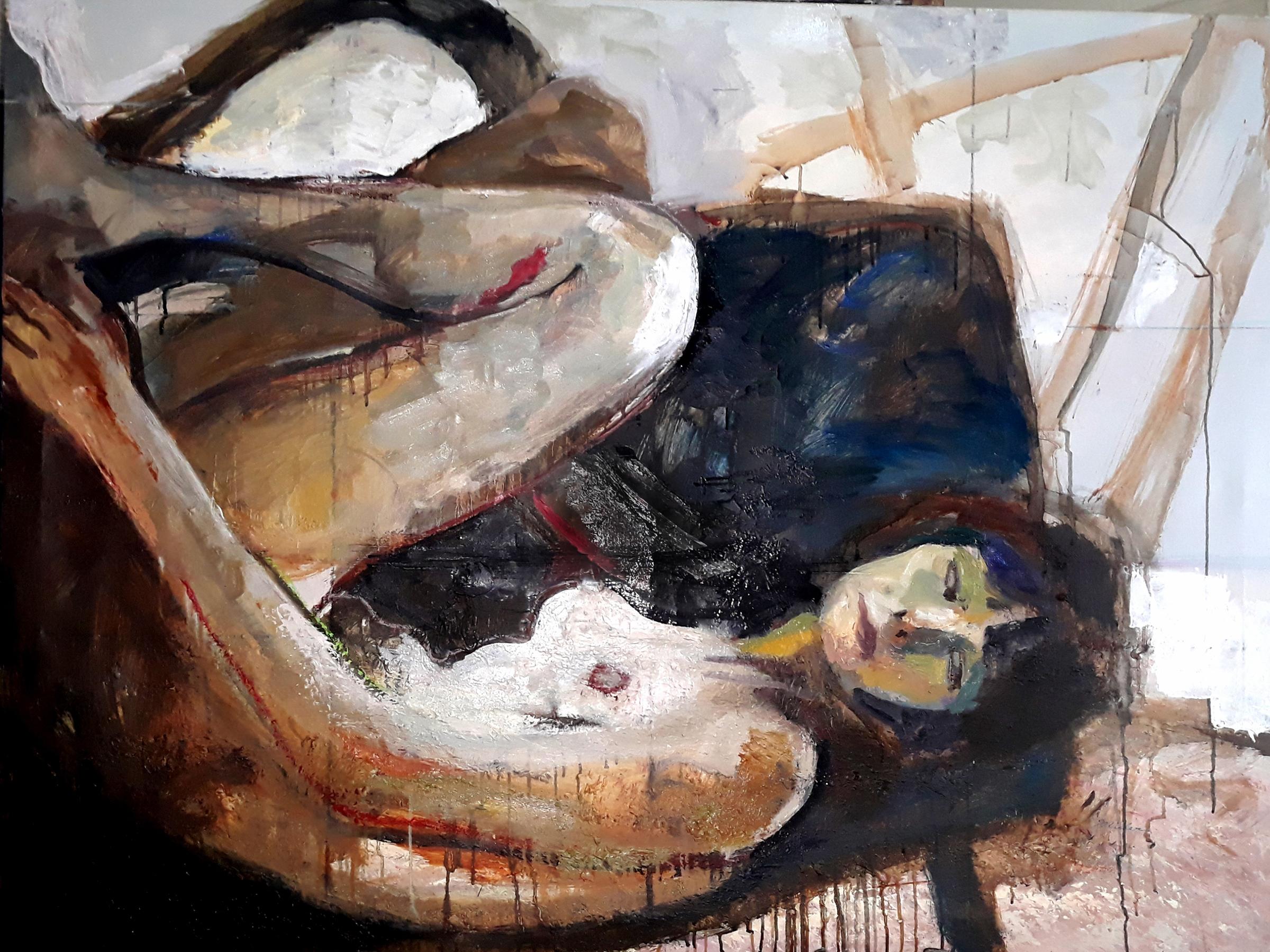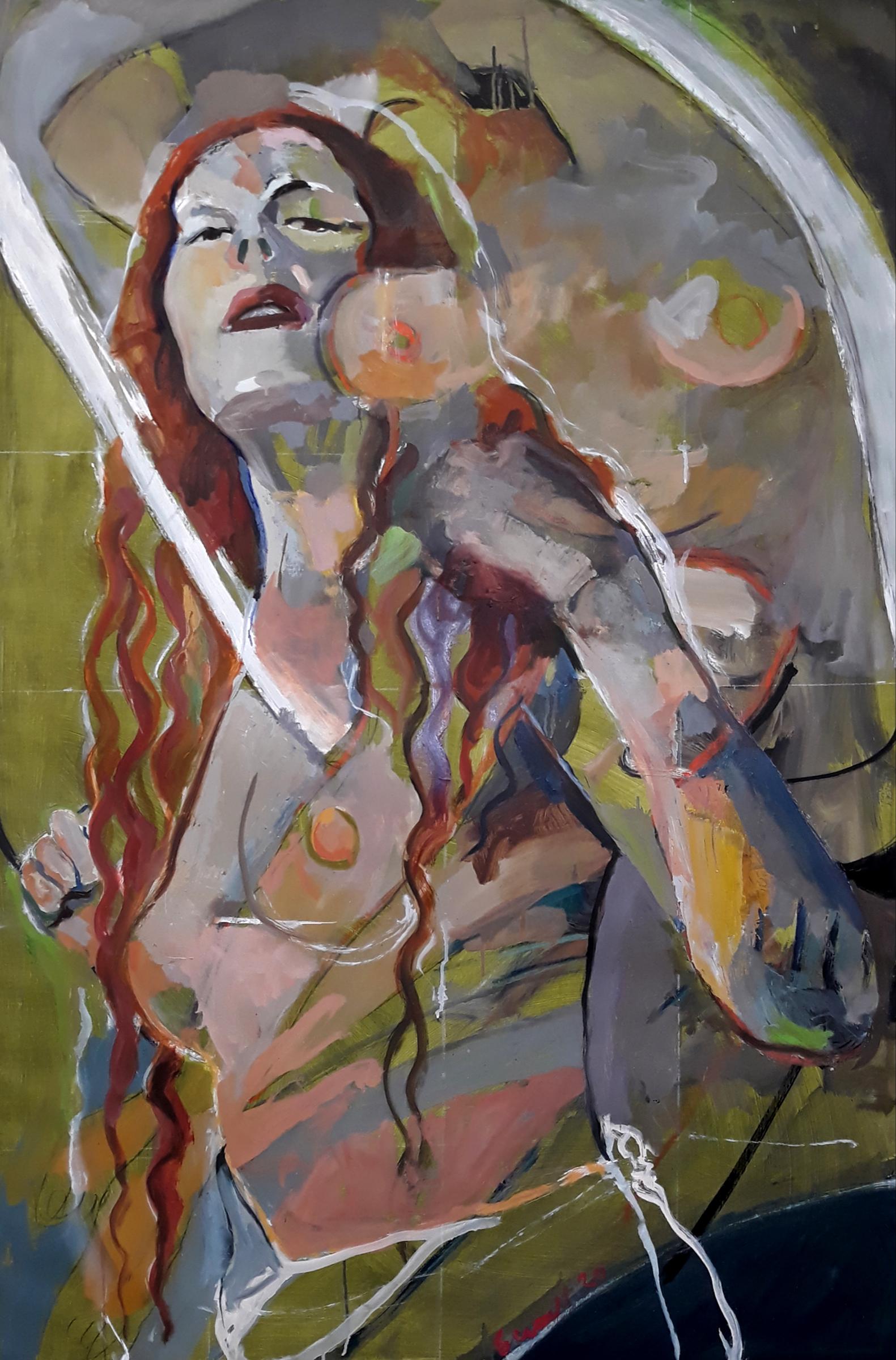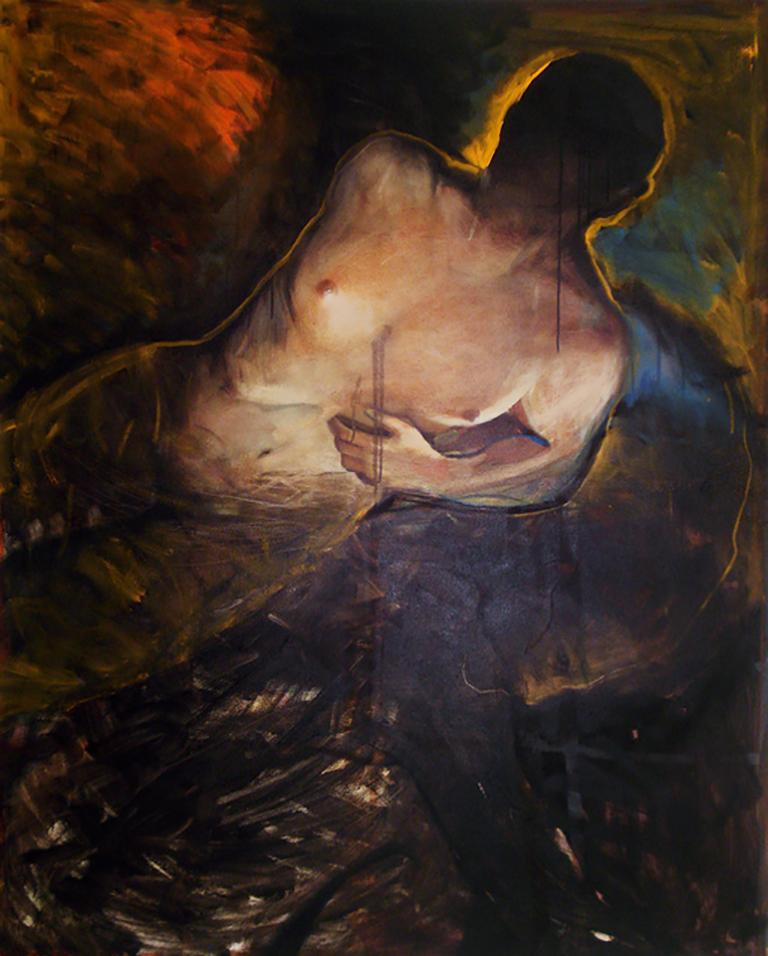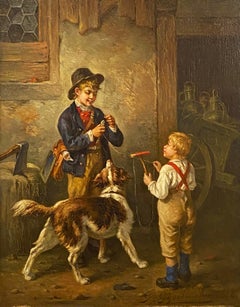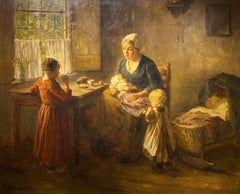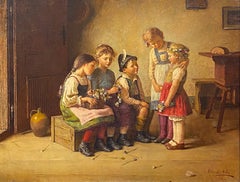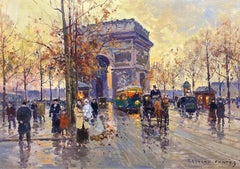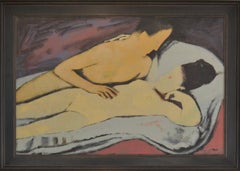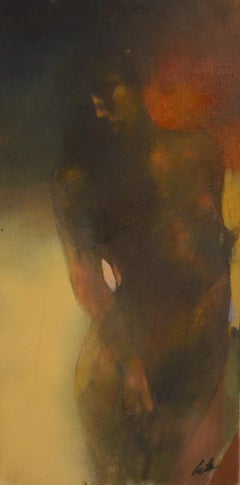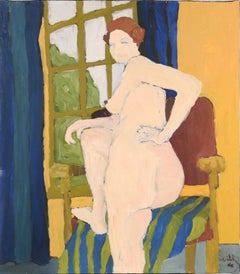Items Similar to Nudes
Video Loading
Want more images or videos?
Request additional images or videos from the seller
1 of 11
Salcia BahncNudes
About the Item
Nudes
By. Salcia Bahnc (Polish, American, 1898-1976)
Signed Lower Middle
Unframed: 14 x 18 inches
Framed: 23 x 26 inches
Painter, illustrator, printmaker, teacher. Born in Dukla, Poland. Though she was born in Dukla, a town in south-eastern Poland, she moved to Prsemysl, one of the largest and most ancient cities of southern Poland, at a young age. Her mother was reportedly descended from the "Van Ast" family, a Dutch dynasty that produced several artists, including Balthasar van der Ast (1593/4 - 1657). According to one art historian she came to New York at the age of five (c. 1903), and another, at the age of eight (c. 1906).
Her family was Jewish and reportedly quite wealthy. Why they would have left imperial Austria, under whose sovereignty either of her proposed birth cities were under, is unknown. However, while these areas did not suffer the pogroms typical in neighboring imperial Russia, the Austro-Hungarian empire had become much more anti-Semetic, which may have hasten there departure. How, according to one source, they ended up living in the Jewish ghetto of New York is extremely puzzling. Did they loose their wealth to some business disaster? Where they forced to leave it behind? Was there some familial tragedy? We may never know.
In her youth she lived first in New York City and then in Boston, Massachusetts, where her family had relatives. It is reported that when she was in fourth grade she was found to be so competent in drawing that for the next two years she taught a drawing class after school for the other children. In Boston, Bahnc's mother eventually remarried and moved the family to Chicago where the young artist was primarily raised.
In Chicago she worked during the days as a sales clerk in a department store. At night she put herself through school at the School of the Art Institute of Chicago (SAIC) and taught at her former alma mater after her graduation during the years 1923-1929. She also studied at the Chicago Academy of Fine Art. She took up design work and began exhibiting painted silk creations at a private Chicago gallery (probably Thurber, see below). The first museum exhibitions she is known to have participated in were held at the Art Institute of Chicago. During this period she became known for her portraits.
Originally a resident alien, she was naturalized at the district court of Chicago, Illinois in July of 1913. In 1920 she lived on East Ontario Street in Chicago in a neighborhood filled with art studios and artists, including James Allen Saint-John (1872-1957), Paul Bartlett (1881-1965), Pauline Palmer (1867-1938), and George Ames Aldrich (1872-1941). It is in Chicago that she saw her greatest success as an artist. In 1927, Chicago art dealer Chester H. Johnson said of her work: "The Art of Salcia Bahnc is a sincere manifestation of the spirit we know as 'Modernism' . . . . . . She is the spirit of the Age, not its Fashion." Local reviewers agreed, one going as far to say that her exhibition was " . . . the most interesting one man show by a young artist that has ever been presented to Chicago, and I keep telling myself that New York will get her if we don't watch out."
She was apparently a favorite and friend of art critic Clarence Joseph Bulliet (1883-1952), who authored a number of books and articles that praised Bahnc's work. Bulliet was central in introducing and popularizing modern art in the mid-western United States. In his book Apples and Madonnas: Emotional Expression in Modern Art (1935) he called Bahnc a "A thorough Expressionist." A year later in his book The Significant Moderns and Their Pictures (1936) he noted that one of her paintings of a nude was ". . . powerful in its elemental brutality."
During this period other critics reported positively on the work she was producing. Ida Ethelwyn Wing reported in a volume of the Delphian Text (1930) that Bahnc, was without doubt, ". . . the most vigorous and intensively original of the American Expressionists." Paul Masserman and Maxwell Baker said of her in their work The Jews come to America (1932) that she was part of a group of artists that were "Chief among modern Jewish painters. . . "
Salcia Bahnc traveled back and forth to Europe during the late 1920s and into the 1930s, a period when she faced the rise of totalitarianism. She wrote about this fact to a fellow artist to whom she commented " . . . about the difficult art scene in Paris . . . . . . and the growing power of fascism." In 1930 she was maintaining a studio in New York City at 1218 East 53rd Street and a residence in Brooklyn, Long Island. She returned to France where she married a French citizen and writer named Eugene Petit (b. 1901) and bore a son there named Alain Petit (b. 1934). She again returned to the United States in November of 1937 and traveled back to France after a brief stay in America. During her stay she continued to exhibit in Chicago, where Quest Galleries gave her a solo show.
Like so many ex-patriot authors and artists who were living in Paris, she found herself trapped in France (first in Paris, then in Mayenne) following the German invasion in 1940. Being of Jewish extraction the situation could prove to be quite dangerous if she were reported or discovered by German authorities. She and her husband were able to obtain passports and escape to Portugal where in August of 1941 they boarded the S. S. Escambion to return to America.
In 1940, American Export Lines, owners of the Escambion, discontinued its normal Mediterranean routes and placed their ships into service sailing from Lisbon, Portugal to New York City. Over the next two years (1940 - 1941) their ships played an important role in transporting thousands of people who were trying to escape the Nazi regime before America's own entry into World War II. One survivor, Ludwig Lowenberg, who sailed on the Escambion on the same day that Bahnc did, reported the ordeal his family endured getting to Lisbon to his own descendants:
"[The family] received their American visa on May 28, 1941, only three days before the U.S. consulate in Stuttgart closed for the duration of World War II. They left Berlin on June 23, 1941, traveling for 27 hours on a locked train to Paris. There they were forced to spend an additional night in the locked train until their coach was attached to a train headed for San Sebastian in Spain. After an overnight hotel stay in San Sebastian, the train (now no longer locked) continued to Lisbon. All in all it took six days from Berlin to Lisbon. They remained for four weeks in Lisbon until they embarked on the Excambion for New York."
Bahnc had given up her citizenship during her time in France and was forced to reapply for naturalization once again upon her return. She was living in New York City at 101 West 85th Street when she was re-naturalized in April of 1947.
Exactly how much of her artwork was lost in Europe is not known. Clearly, she would not have been able to bring much, if anything, with her during her escape. One writer had noted that between 1930 and 1934 she had worked hard to prepare a large group of new works for a show in Paris. Between those, and what she would have produced during the next six years, the actual amount of the loss might have been staggering. Bahnc's 1942 exhibition with Julio de Diego included works recalling the suffering going on in Europe. One work in the exhibition was a portrait of the painter Katherine Dudley, who, at the time, was reportedly interned near Paris.
In the later years of her career she worked extensively as a teacher and illustrator of children's books. In 1950 she taught at the Evanston Art Center, where she lead a demonstration in portrait painting. She authored or illustrated a number of works during and after World War II, including: The House in the Tree and Other Stories of Places, People and Things (1941); Claude Of France: The Story Of Debussy For Young People (1948); Time for Poetry (1951); Hidden Silver (1952); From Many Lands - The Children's Hour, Volume 9 (1969); and That Boy (no date). She returned to teach at the School of the Art Institute of Chicago during 1943-44 and 1947-53; and taught later at the Garrison Forest School in Garrison, Maryland, from 1955-57.
Bahnc was known to have exhibited widely, both in Europe and in America. Her known lifetime exhibitions include: The Art Institute of Chicago, Chicago, IL, 1919-29, 1942 (The 53rd Annual; and Room of Chicago Art: Exhibition of Paintings by Salcia Bahnc and Julio de Diego), 1943; Chicago Architectural Sketch Club, Chicago, IL, 1921; Whitney Museum of American Art, New York, NY, 1922 (prize), 1923 (prize); Pennsylvania Academy of Fine Art, Philadelphia, PA, 1925; Chester H. Johnson Galleries, Chicago, IL, 1925, 1927 (solo), 1929, 1930 (solo), 1931 (solo); Architectural League, Chicago, IL, 1925; Marie Sterner Gallery, New York, NY, 1928; Society of Independent Artists, New York, NY, 1928; Women's World Fair Exhibition, Chicago, IL, 1928; Sur.-Independents, Paris, France, 1929; Brooklyn Museum of Art, Brooklyn, NY, 1932; Gallerie La Jeune Peinture, Paris, France, 1934 (solo); Salon des Tuileries, Paris, France, 1930-1935; Annual Exhibition of Works by Chicago and Vicinity Artists Exhibition, Chicago, IL, 1935 (prize), 1942 (held at AIC, prize); Findlay Galleries, Chicago, IL, 1935, 1950; Quest Galleries, Chicago, IL, 1938 (solo); Albert Roullier Galleries, Chicago, IL, 1943 (solo); Bahnc Studio Exhibition, Chicago, IL, 1949 (solo); Louise and Thurman Nicholson Gallery, Chicago, IL, 1950 (retrospective); Art Gallery of the College of Jewish Studies, Chicago, Il, 1950 (solo); Thurber Art Galleries, Chicago, IL, c. 1920s.
Salcia Bahnc Petit died in the borough of the Bronx, New York, on Tuesday, the 1st of May 1979. She was 87 years old.
Since her death, Bahnc's works have been included in more recent museum exhibitions, including "The Emergence of Modernism in Illinois 1914-1940," held at the Illinois State Museum, Springfield, IL, 1976; and "New Woman in Chicago, 1910-45: Paintings from Illinois Collections," held at Rockford College and Illinois State Museum, Springfield, IL, 1993-94.
Her works are held in a number of private collections and by the following institutions: Illinois State Museum, Springfield, IL; Princeton Art Museum, Princeton, NJ; The Arts Club of Chicago, Chicago, IL; and The Art Institute of Chicago, Chicago, IL.
- Creator:Salcia Bahnc (1896 - 1979, Polish, American)
- Dimensions:Height: 14 in (35.56 cm)Width: 18 in (45.72 cm)
- Medium:
- Movement & Style:
- Period:
- Condition:
- Gallery Location:Missouri, MO
- Reference Number:1stDibs: LU747312419122
About the Seller
5.0
Vetted Seller
These experienced sellers undergo a comprehensive evaluation by our team of in-house experts.
Established in 1970
1stDibs seller since 2017
148 sales on 1stDibs
Typical response time: 1 to 2 days
- ShippingRetrieving quote...Ships From: Missouri, MO
- Return PolicyA return for this item may be initiated within 2 days of delivery.
Authenticity Guarantee
In the unlikely event there’s an issue with an item’s authenticity, contact us within 1 year for a full refund. DetailsMoney-Back Guarantee
If your item is not as described, is damaged in transit, or does not arrive, contact us within 7 days for a full refund. Details24-Hour Cancellation
You have a 24-hour grace period in which to reconsider your purchase, with no questions asked.Vetted Professional Sellers
Our world-class sellers must adhere to strict standards for service and quality, maintaining the integrity of our listings.Price-Match Guarantee
If you find that a seller listed the same item for a lower price elsewhere, we’ll match it.Trusted Global Delivery
Our best-in-class carrier network provides specialized shipping options worldwide, including custom delivery.More From This Seller
View AllReadying for Play
Located in Missouri, MO
Framed Size: 25.5 x 23 inches
Joseph Gyselinckx was born in 1817. He was a genre painter in Antwerp. The artist was a student of F. de Brakeleer. He had two paintings included in ...
Category
Late 19th Century Realist Figurative Paintings
Materials
Oil, Canvas
Price Upon Request
Mother and Children
By Bernard De Hoog
Located in Missouri, MO
Bernard DeHoog (1867-1943)
"Mother and Children"
Oil on Canvas
Signed Lower Left
Site Size: approx. 32.5 x 39.5 inches
Framed Size: approx. 39 x ...
Category
Late 19th Century Realist Figurative Paintings
Materials
Oil, Canvas
Price Upon Request
Presenting the Bouquet
By Edmund Adler
Located in Missouri, MO
Canvas Size: approx. 22 x 27 inches
Framed Size: approx. 29 x 34 inches
Edmund Adler (Austrian) 1876-1965
Known for his naturalness in color and expression, the artist Edmund...
Category
Early 20th Century Realist Figurative Paintings
Materials
Oil, Canvas
Price Upon Request
Avenue de Friedland, L’Arc de Triomphe
By Édouard Leon Cortès
Located in Missouri, MO
Framed Size: 21 x 26 inches
*This work has been authenticated by Nicole Verdier
Provenance: Johnson Gallery, Chicago IL, circa 1967/1968
Cortès was born in Lagny, France on April 26, 1882. During his early lifetime, Paris was the center of the art world. Artist from across the globe traveled there to study and paint it's beautiful countryside and cities; views of Paris, or as it became known 'the City of Lights', were in great demand by both collectors and tourists. Édouard Cortès, along with other artists like Eugene Galien-Laloue (1854-1941), Luigi Loir (1845-1916) and Jean Beraud (1849-1936) answered their call.
Specializing in Paris street scenes, each of these artists captured the city during its heyday and continued with these scenes well into the 20th century.Édouard was the son of Antonio Cortès - the Spanish Court painter - who was himself the son of the artisan André Cortès...
Category
Mid-20th Century Impressionist Landscape Paintings
Materials
Oil, Canvas
Price Upon Request
Breton Chores
Located in Missouri, MO
Clement Nye Swift
"Breton Chores" 1870
Oil on Canvas
Signed and Dated Lower Right
Canvas Size: approx 27 x18 inches
Framed Size: approx 34 x 35 inches
Provenance: Private Midwes...
Category
1870s Victorian Figurative Paintings
Materials
Oil, Canvas
Price Upon Request
In the Boudoir
By Delphin Enjolras
Located in Missouri, MO
Delphin Enjolras
"In the Boudoir"
Oil on Canvas
Signed Lower Left
Canvas: approx 29 x 22 inches
Framed: approx. 37 x 30 inches
Renowned as a portraitist of the upper echelons of s...
Category
Early 20th Century Academic Figurative Paintings
Materials
Oil, Canvas
Price Upon Request
You May Also Like
"Erste Beruhrung" First Stirrings
By Ernst Neuschul
Located in Brecon, Powys
Oil on canvas, signed and dated 'EN [19]63' lower right, titled and dated to stretcher, numbered 33 and with paper label 34 to stretcher,
From the family of the artist by direct des...
Category
1960s Expressionist Figurative Paintings
Materials
Oil, Canvas
Emerging, Bill Bate, Original Figurative Painting, Nude Portraiture, Affordable
By Bill Bate
Located in Deddington, GB
Bill Bate
Emerging
Original Figurative Painting
Oil Paint on Canvas
Canvas Size: H 60cm x W 30cm x D 2cm
Sold Unframed
Please note that in situ images are purely an indication of how...
Category
21st Century and Contemporary Expressionist Nude Paintings
Materials
Oil, Canvas
Nude by the Window, San Francisco Bay Area Figurative Movement 1966
By Thomas L. Tribby
Located in Soquel, CA
Bay Area figurative painting of a nude woman looking over her shoulder by Thomas L. Tribby (American, b. 1944). Signed and dated "Tribby 66" in the lower right corner. Unframed, but the edges are painted black for a frame-less display. Canvas size: 37.5"H x 33.5"W. Bay area figurative artist and painted while at the University of California, Berkeley, CA – Bachelor of Arts, 1963-1966. Flat rate Shipping $100 quoted.
Thomas Tribby (American, b. 1944) is an internationally known artist who has participated in solo and group exhibitions in the United States and Europe.
He works in a variety of media, including watercolor, acrylic, and oil. Tribby has gallery representation in Florida and his paintings have been featured in articles in Waterfront Home and Design and Architectural Digest. Tribby has participated in juried and invitational shows in Florida, California, Arizona, Georgia, South Carolina, Tennessee, Washington, D.C., and New York, and in Paris, France.
In December 2007, Tribby had the honor of being one of nine painters in the American Delegation at Le Salon des Beaux Arts de la Société Nationale des Beaux Arts exhibition, known as the Paris Salon, at the Carrousel du Louvre in Paris, where his painting, Lifeguard, was exhibited.
In January 2008 Tribby received from the Design Center of the Americas, DCOTA, the prestigious Stars of Design award in the category of Art.
Tribby lives and works in West Palm Beach, Florida.
EDUCATION
1961-1963 University of Washington, Seattle, WA Studies in Fine Arts
1963-1966 University of California, Berkeley, CA – Bachelor of Arts
1969-1970 Arizona State University, Tempe, AZ, Grad Studies, MFA Program
1979-1980 Arizona State University, Tempe, AZ, Grad Studies, MFA Program
GROUP EXHIBITIONS: INVITATIONAL OR JURIED
2014 Monochrome, Palm Beach Cultural Council, Lake Worth, FL
2010 Spectrum 2010, The Hunter Museum of American Art, Chattanooga, TN
2010 Studio 1608 Group Show, West Palm Beach, FL
2008 Florida Original Contemporary Art, West Palm Beach, FL
2007 Paris Salon, Carrousel du Louvre, Paris, France
2005 Liman Gallery, Palm Beach, FL
2003 Grand Bank and Trust, Palm Beach Gardens, FL
2003 Aaron Gallery, Washington D.C.
2001 The Retreat, Artists Against Abuse, Southampton, NY
2000, 2003-2004 Palm Street Art Studios, West Palm Beach, FL
1996 Studio 412, Group Show, West Palm Beach, FL
1992, 1994 Small Works Show, Armory Arts Center, WPB, FL
ONE MAN EXHIBITIONS
2018 Armand Bolling Fine Arts, Jupiter, FL
2012, 2016 Ellis-Nicholson Gallery...
Category
1960s Expressionist Figurative Paintings
Materials
Oil, Stretcher Bars, Canvas
$2,280 Sale Price
20% Off
Unfinished Thought, female nude, abstracted figurative painting earth tones
By Tom Bennett
Located in Brooklyn, NY
Expressionist, abstracted figurative female nude
About Tom Bennett:
With quick brushstrokes, Tom Bennett creates representational images of human figures and animals, emphasizing mo...
Category
21st Century and Contemporary Expressionist Figurative Paintings
Materials
Oil, Canvas
Red Ophelia, colorful abstract female nude
By Tom Bennett
Located in Brooklyn, NY
An expressionist figurative oil painting integrating abstracted form and color. The title suggests the classic Shakespearean character from Hamlet and the symbolism of beauty, madnes...
Category
2010s Expressionist Figurative Paintings
Materials
Canvas, Oil
After Icarus, ghostly floating figure, black w orange, blue nude
By Audrey Anastasi
Located in Brooklyn, NY
Oil on canvas
ABOUT the artist:
Audrey Frank Anastasi is a prolific feminist artist, working in painting, drawing, collage, mixed media, & printmaking. She is also curator, gallerist, educator and arts advocate. Most of Ms. Anastasi's figurative works are painted with her non-dominant left hand. She has created large bodies of works of birds, animals and birch trees.
She has had 20 solo & 200 group shows. Her "ref-u-gee" series will be shown in 2020 at Medgar Evers College in collaboration with the Valentine Museum of Art, Brooklyn. Accompanying the show will be a limited-edition monograph w/ over 180 images and a foreword by Phyllis Braff. Ms. Anastasi's collage series was exhibited at Welancora Gallery, Brooklyn, in May, 2019. In 2018, ten paintings were exhibited in "Painting to Survive," curated by Yale critic Jonathan Weinberg.
Book and catalog publications include "Stations of the Cross", SPQR press, BREUCKELEN magazine, “Audrey Frank Anastasi”, catalog essay Cindy Nemser, and "Collage," essay by Giancarlo T. Roma.
Public art includes a portrait of Jo Davidson...
Category
2010s Expressionist Figurative Paintings
Materials
Oil, Canvas
Recently Viewed
View AllMore Ways To Browse
Nude From Behind
Russia Nude
Nude Youth
The Nude Young Man In Art
Man Nude Art Large
Silver Women Nude
Nude German Woman
Silk Framed Pictures
German Expressionist 1920s
Nude Boy
German Portrait Painting 1920
1950s Dutch Paintings
French Street Scene 1950s
Man Nude Painting Large
Russian Empire Painting
Nude Old Man
Russian Women Portrait Painting
1930s Fashion Drawing
